PROJ 6008 - Leadership: Catherine Livingstone at Commonwealth Bank AU
VerifiedAdded on 2023/04/19
|9
|2156
|245
Report
AI Summary
This report provides an in-depth analysis of Catherine Livingstone's leadership skills and characteristics as the chairwoman of the Commonwealth Bank of Australia. It evaluates her leadership qualities such as self-confidence, effective communication, and decision-making capabilities in the context of today's economic environment. The report also explores how past failures influenced her shift from an autocratic to a democratic leadership style, emphasizing collaboration and shared decision-making. Furthermore, it discusses her implementation of situational leadership, which allows for flexibility and adaptability in various situations, ultimately enhancing employee engagement, productivity, and overall performance within the organization. The analysis demonstrates how Livingstone's leadership approach has contributed to the success of Commonwealth Bank of Australia.
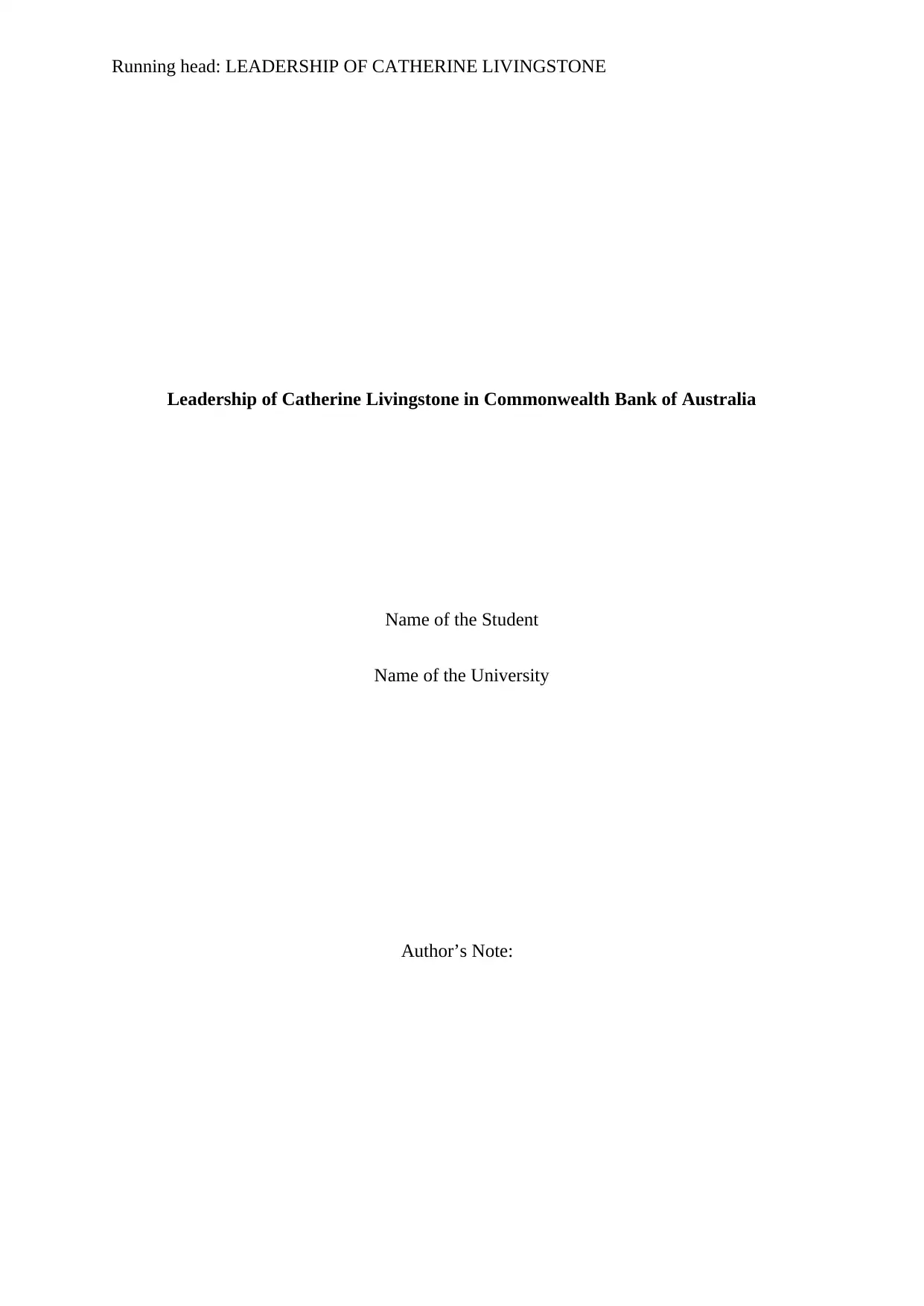
Running head: LEADERSHIP OF CATHERINE LIVINGSTONE
Leadership of Catherine Livingstone in Commonwealth Bank of Australia
Name of the Student
Name of the University
Author’s Note:
Leadership of Catherine Livingstone in Commonwealth Bank of Australia
Name of the Student
Name of the University
Author’s Note:
Paraphrase This Document
Need a fresh take? Get an instant paraphrase of this document with our AI Paraphraser
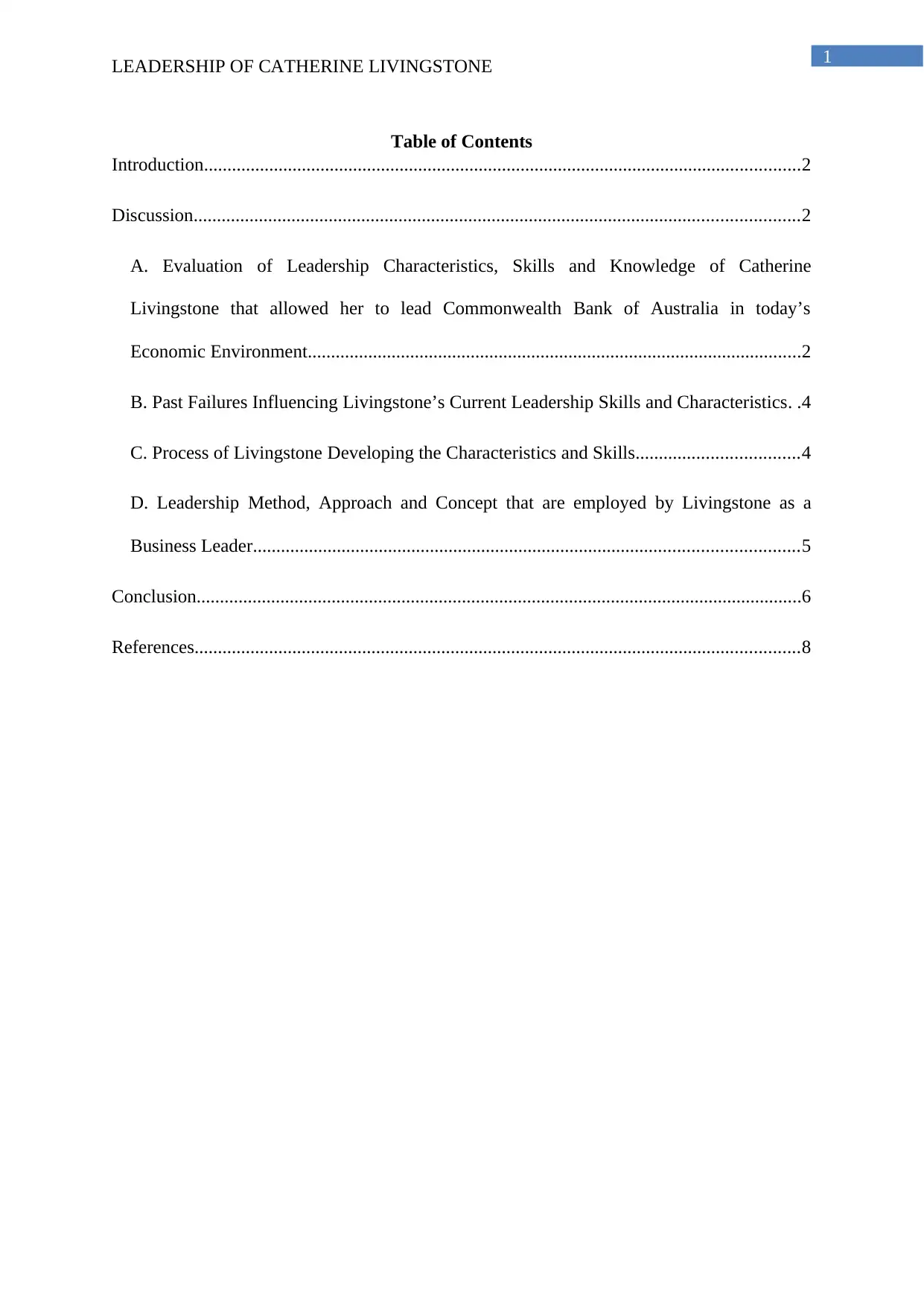
1
LEADERSHIP OF CATHERINE LIVINGSTONE
Table of Contents
Introduction................................................................................................................................2
Discussion..................................................................................................................................2
A. Evaluation of Leadership Characteristics, Skills and Knowledge of Catherine
Livingstone that allowed her to lead Commonwealth Bank of Australia in today’s
Economic Environment..........................................................................................................2
B. Past Failures Influencing Livingstone’s Current Leadership Skills and Characteristics. .4
C. Process of Livingstone Developing the Characteristics and Skills...................................4
D. Leadership Method, Approach and Concept that are employed by Livingstone as a
Business Leader.....................................................................................................................5
Conclusion..................................................................................................................................6
References..................................................................................................................................8
LEADERSHIP OF CATHERINE LIVINGSTONE
Table of Contents
Introduction................................................................................................................................2
Discussion..................................................................................................................................2
A. Evaluation of Leadership Characteristics, Skills and Knowledge of Catherine
Livingstone that allowed her to lead Commonwealth Bank of Australia in today’s
Economic Environment..........................................................................................................2
B. Past Failures Influencing Livingstone’s Current Leadership Skills and Characteristics. .4
C. Process of Livingstone Developing the Characteristics and Skills...................................4
D. Leadership Method, Approach and Concept that are employed by Livingstone as a
Business Leader.....................................................................................................................5
Conclusion..................................................................................................................................6
References..................................................................................................................................8
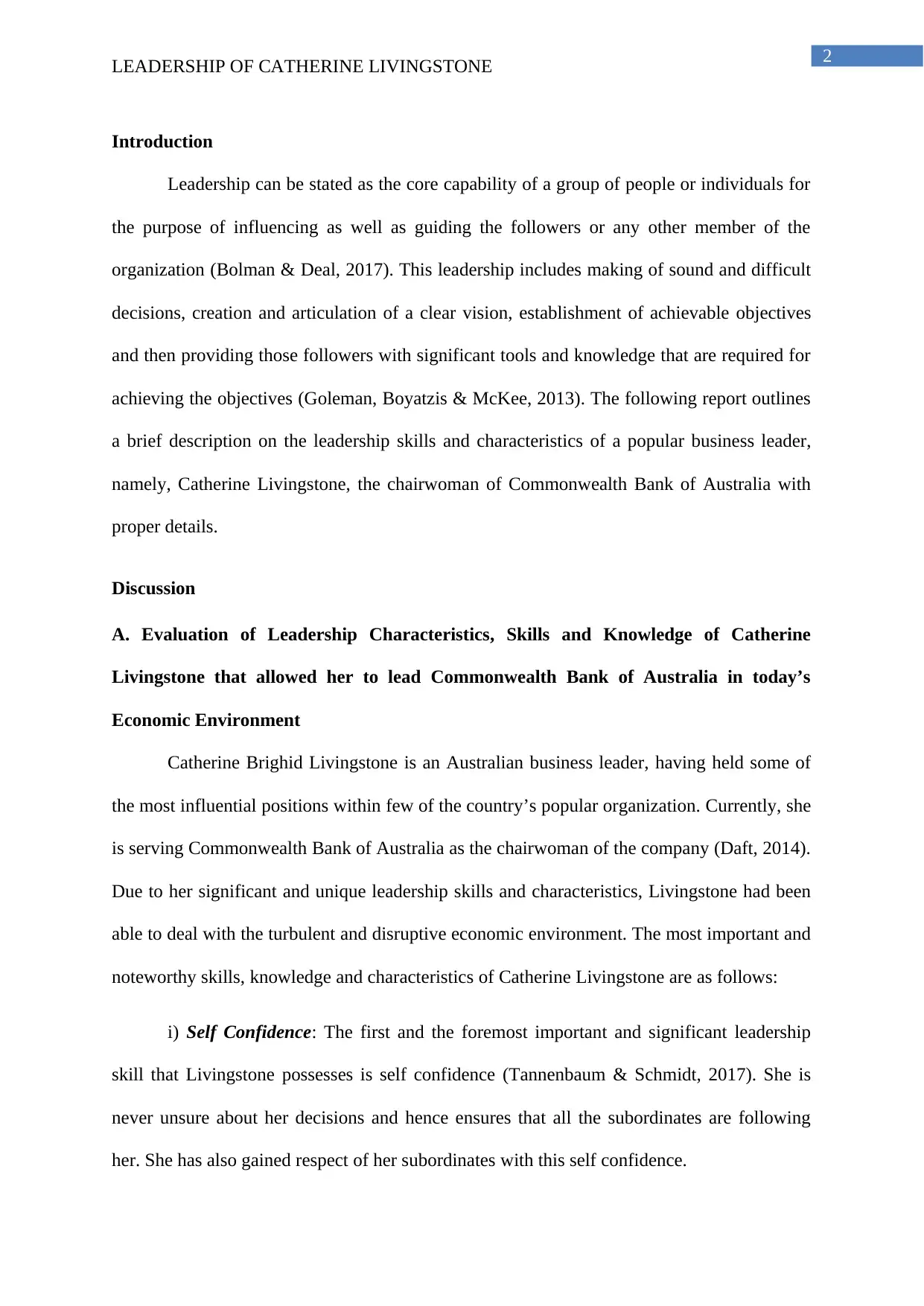
2
LEADERSHIP OF CATHERINE LIVINGSTONE
Introduction
Leadership can be stated as the core capability of a group of people or individuals for
the purpose of influencing as well as guiding the followers or any other member of the
organization (Bolman & Deal, 2017). This leadership includes making of sound and difficult
decisions, creation and articulation of a clear vision, establishment of achievable objectives
and then providing those followers with significant tools and knowledge that are required for
achieving the objectives (Goleman, Boyatzis & McKee, 2013). The following report outlines
a brief description on the leadership skills and characteristics of a popular business leader,
namely, Catherine Livingstone, the chairwoman of Commonwealth Bank of Australia with
proper details.
Discussion
A. Evaluation of Leadership Characteristics, Skills and Knowledge of Catherine
Livingstone that allowed her to lead Commonwealth Bank of Australia in today’s
Economic Environment
Catherine Brighid Livingstone is an Australian business leader, having held some of
the most influential positions within few of the country’s popular organization. Currently, she
is serving Commonwealth Bank of Australia as the chairwoman of the company (Daft, 2014).
Due to her significant and unique leadership skills and characteristics, Livingstone had been
able to deal with the turbulent and disruptive economic environment. The most important and
noteworthy skills, knowledge and characteristics of Catherine Livingstone are as follows:
i) Self Confidence: The first and the foremost important and significant leadership
skill that Livingstone possesses is self confidence (Tannenbaum & Schmidt, 2017). She is
never unsure about her decisions and hence ensures that all the subordinates are following
her. She has also gained respect of her subordinates with this self confidence.
LEADERSHIP OF CATHERINE LIVINGSTONE
Introduction
Leadership can be stated as the core capability of a group of people or individuals for
the purpose of influencing as well as guiding the followers or any other member of the
organization (Bolman & Deal, 2017). This leadership includes making of sound and difficult
decisions, creation and articulation of a clear vision, establishment of achievable objectives
and then providing those followers with significant tools and knowledge that are required for
achieving the objectives (Goleman, Boyatzis & McKee, 2013). The following report outlines
a brief description on the leadership skills and characteristics of a popular business leader,
namely, Catherine Livingstone, the chairwoman of Commonwealth Bank of Australia with
proper details.
Discussion
A. Evaluation of Leadership Characteristics, Skills and Knowledge of Catherine
Livingstone that allowed her to lead Commonwealth Bank of Australia in today’s
Economic Environment
Catherine Brighid Livingstone is an Australian business leader, having held some of
the most influential positions within few of the country’s popular organization. Currently, she
is serving Commonwealth Bank of Australia as the chairwoman of the company (Daft, 2014).
Due to her significant and unique leadership skills and characteristics, Livingstone had been
able to deal with the turbulent and disruptive economic environment. The most important and
noteworthy skills, knowledge and characteristics of Catherine Livingstone are as follows:
i) Self Confidence: The first and the foremost important and significant leadership
skill that Livingstone possesses is self confidence (Tannenbaum & Schmidt, 2017). She is
never unsure about her decisions and hence ensures that all the subordinates are following
her. She has also gained respect of her subordinates with this self confidence.
⊘ This is a preview!⊘
Do you want full access?
Subscribe today to unlock all pages.

Trusted by 1+ million students worldwide
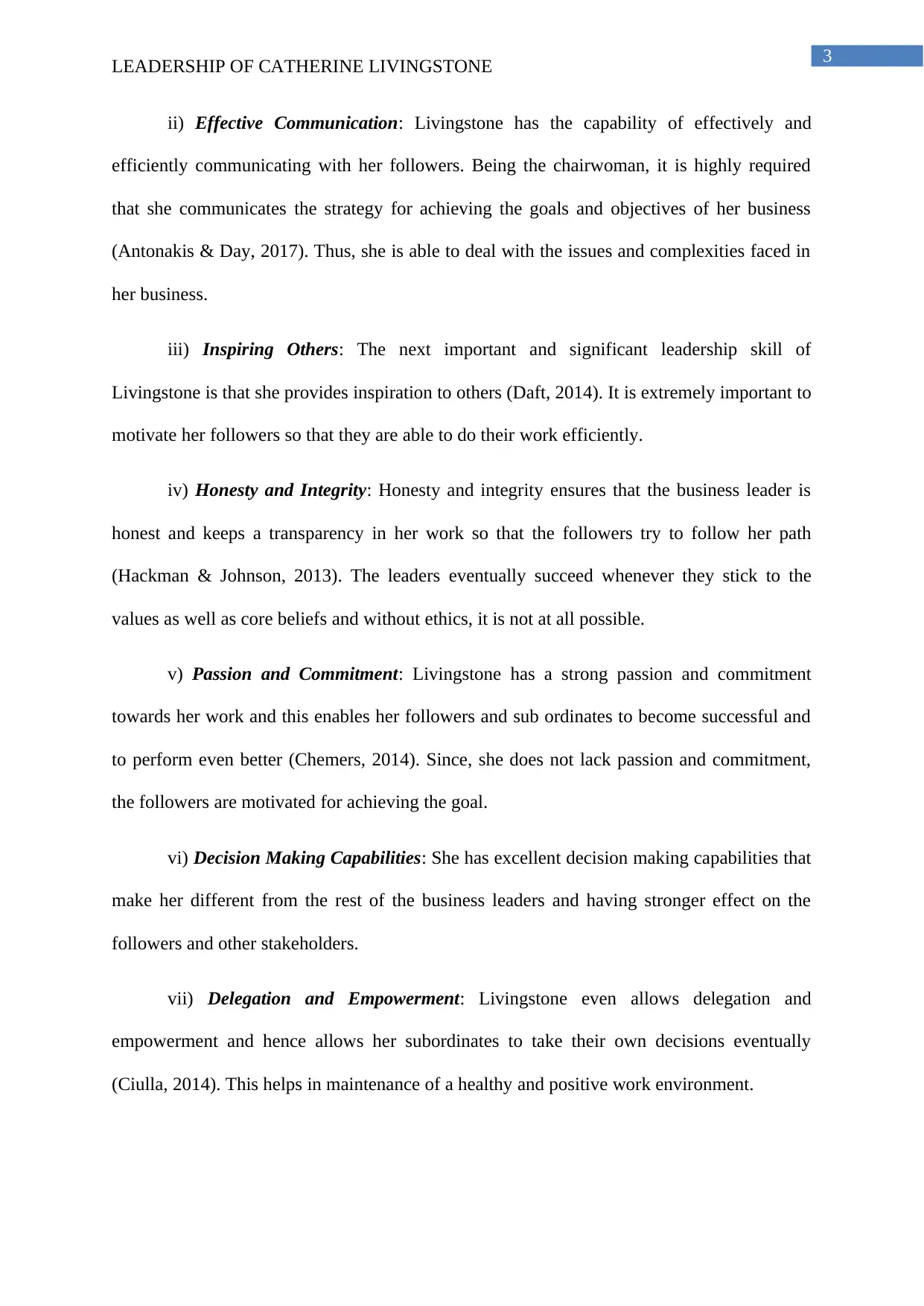
3
LEADERSHIP OF CATHERINE LIVINGSTONE
ii) Effective Communication: Livingstone has the capability of effectively and
efficiently communicating with her followers. Being the chairwoman, it is highly required
that she communicates the strategy for achieving the goals and objectives of her business
(Antonakis & Day, 2017). Thus, she is able to deal with the issues and complexities faced in
her business.
iii) Inspiring Others: The next important and significant leadership skill of
Livingstone is that she provides inspiration to others (Daft, 2014). It is extremely important to
motivate her followers so that they are able to do their work efficiently.
iv) Honesty and Integrity: Honesty and integrity ensures that the business leader is
honest and keeps a transparency in her work so that the followers try to follow her path
(Hackman & Johnson, 2013). The leaders eventually succeed whenever they stick to the
values as well as core beliefs and without ethics, it is not at all possible.
v) Passion and Commitment: Livingstone has a strong passion and commitment
towards her work and this enables her followers and sub ordinates to become successful and
to perform even better (Chemers, 2014). Since, she does not lack passion and commitment,
the followers are motivated for achieving the goal.
vi) Decision Making Capabilities: She has excellent decision making capabilities that
make her different from the rest of the business leaders and having stronger effect on the
followers and other stakeholders.
vii) Delegation and Empowerment: Livingstone even allows delegation and
empowerment and hence allows her subordinates to take their own decisions eventually
(Ciulla, 2014). This helps in maintenance of a healthy and positive work environment.
LEADERSHIP OF CATHERINE LIVINGSTONE
ii) Effective Communication: Livingstone has the capability of effectively and
efficiently communicating with her followers. Being the chairwoman, it is highly required
that she communicates the strategy for achieving the goals and objectives of her business
(Antonakis & Day, 2017). Thus, she is able to deal with the issues and complexities faced in
her business.
iii) Inspiring Others: The next important and significant leadership skill of
Livingstone is that she provides inspiration to others (Daft, 2014). It is extremely important to
motivate her followers so that they are able to do their work efficiently.
iv) Honesty and Integrity: Honesty and integrity ensures that the business leader is
honest and keeps a transparency in her work so that the followers try to follow her path
(Hackman & Johnson, 2013). The leaders eventually succeed whenever they stick to the
values as well as core beliefs and without ethics, it is not at all possible.
v) Passion and Commitment: Livingstone has a strong passion and commitment
towards her work and this enables her followers and sub ordinates to become successful and
to perform even better (Chemers, 2014). Since, she does not lack passion and commitment,
the followers are motivated for achieving the goal.
vi) Decision Making Capabilities: She has excellent decision making capabilities that
make her different from the rest of the business leaders and having stronger effect on the
followers and other stakeholders.
vii) Delegation and Empowerment: Livingstone even allows delegation and
empowerment and hence allows her subordinates to take their own decisions eventually
(Ciulla, 2014). This helps in maintenance of a healthy and positive work environment.
Paraphrase This Document
Need a fresh take? Get an instant paraphrase of this document with our AI Paraphraser
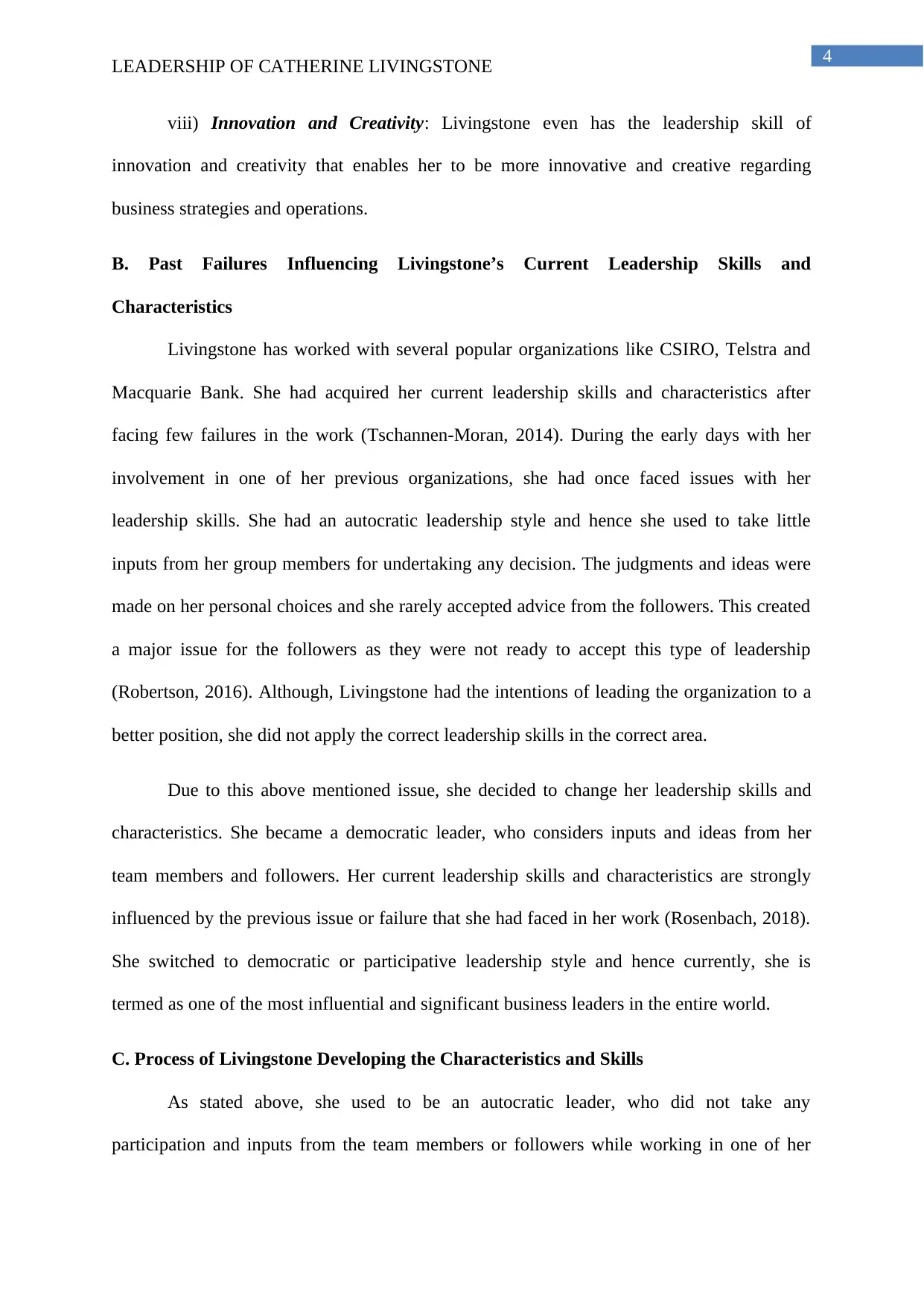
4
LEADERSHIP OF CATHERINE LIVINGSTONE
viii) Innovation and Creativity: Livingstone even has the leadership skill of
innovation and creativity that enables her to be more innovative and creative regarding
business strategies and operations.
B. Past Failures Influencing Livingstone’s Current Leadership Skills and
Characteristics
Livingstone has worked with several popular organizations like CSIRO, Telstra and
Macquarie Bank. She had acquired her current leadership skills and characteristics after
facing few failures in the work (Tschannen-Moran, 2014). During the early days with her
involvement in one of her previous organizations, she had once faced issues with her
leadership skills. She had an autocratic leadership style and hence she used to take little
inputs from her group members for undertaking any decision. The judgments and ideas were
made on her personal choices and she rarely accepted advice from the followers. This created
a major issue for the followers as they were not ready to accept this type of leadership
(Robertson, 2016). Although, Livingstone had the intentions of leading the organization to a
better position, she did not apply the correct leadership skills in the correct area.
Due to this above mentioned issue, she decided to change her leadership skills and
characteristics. She became a democratic leader, who considers inputs and ideas from her
team members and followers. Her current leadership skills and characteristics are strongly
influenced by the previous issue or failure that she had faced in her work (Rosenbach, 2018).
She switched to democratic or participative leadership style and hence currently, she is
termed as one of the most influential and significant business leaders in the entire world.
C. Process of Livingstone Developing the Characteristics and Skills
As stated above, she used to be an autocratic leader, who did not take any
participation and inputs from the team members or followers while working in one of her
LEADERSHIP OF CATHERINE LIVINGSTONE
viii) Innovation and Creativity: Livingstone even has the leadership skill of
innovation and creativity that enables her to be more innovative and creative regarding
business strategies and operations.
B. Past Failures Influencing Livingstone’s Current Leadership Skills and
Characteristics
Livingstone has worked with several popular organizations like CSIRO, Telstra and
Macquarie Bank. She had acquired her current leadership skills and characteristics after
facing few failures in the work (Tschannen-Moran, 2014). During the early days with her
involvement in one of her previous organizations, she had once faced issues with her
leadership skills. She had an autocratic leadership style and hence she used to take little
inputs from her group members for undertaking any decision. The judgments and ideas were
made on her personal choices and she rarely accepted advice from the followers. This created
a major issue for the followers as they were not ready to accept this type of leadership
(Robertson, 2016). Although, Livingstone had the intentions of leading the organization to a
better position, she did not apply the correct leadership skills in the correct area.
Due to this above mentioned issue, she decided to change her leadership skills and
characteristics. She became a democratic leader, who considers inputs and ideas from her
team members and followers. Her current leadership skills and characteristics are strongly
influenced by the previous issue or failure that she had faced in her work (Rosenbach, 2018).
She switched to democratic or participative leadership style and hence currently, she is
termed as one of the most influential and significant business leaders in the entire world.
C. Process of Livingstone Developing the Characteristics and Skills
As stated above, she used to be an autocratic leader, who did not take any
participation and inputs from the team members or followers while working in one of her
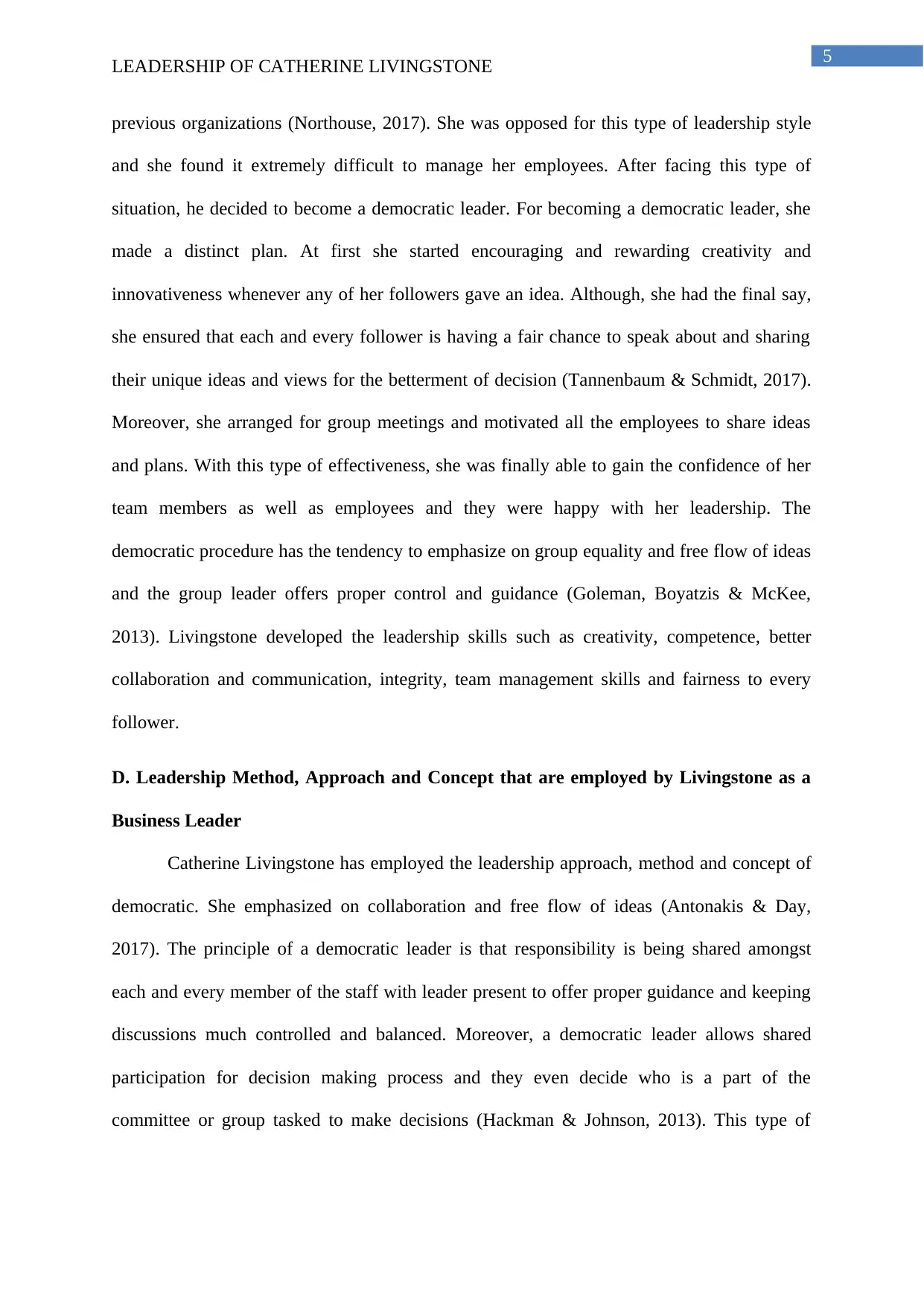
5
LEADERSHIP OF CATHERINE LIVINGSTONE
previous organizations (Northouse, 2017). She was opposed for this type of leadership style
and she found it extremely difficult to manage her employees. After facing this type of
situation, he decided to become a democratic leader. For becoming a democratic leader, she
made a distinct plan. At first she started encouraging and rewarding creativity and
innovativeness whenever any of her followers gave an idea. Although, she had the final say,
she ensured that each and every follower is having a fair chance to speak about and sharing
their unique ideas and views for the betterment of decision (Tannenbaum & Schmidt, 2017).
Moreover, she arranged for group meetings and motivated all the employees to share ideas
and plans. With this type of effectiveness, she was finally able to gain the confidence of her
team members as well as employees and they were happy with her leadership. The
democratic procedure has the tendency to emphasize on group equality and free flow of ideas
and the group leader offers proper control and guidance (Goleman, Boyatzis & McKee,
2013). Livingstone developed the leadership skills such as creativity, competence, better
collaboration and communication, integrity, team management skills and fairness to every
follower.
D. Leadership Method, Approach and Concept that are employed by Livingstone as a
Business Leader
Catherine Livingstone has employed the leadership approach, method and concept of
democratic. She emphasized on collaboration and free flow of ideas (Antonakis & Day,
2017). The principle of a democratic leader is that responsibility is being shared amongst
each and every member of the staff with leader present to offer proper guidance and keeping
discussions much controlled and balanced. Moreover, a democratic leader allows shared
participation for decision making process and they even decide who is a part of the
committee or group tasked to make decisions (Hackman & Johnson, 2013). This type of
LEADERSHIP OF CATHERINE LIVINGSTONE
previous organizations (Northouse, 2017). She was opposed for this type of leadership style
and she found it extremely difficult to manage her employees. After facing this type of
situation, he decided to become a democratic leader. For becoming a democratic leader, she
made a distinct plan. At first she started encouraging and rewarding creativity and
innovativeness whenever any of her followers gave an idea. Although, she had the final say,
she ensured that each and every follower is having a fair chance to speak about and sharing
their unique ideas and views for the betterment of decision (Tannenbaum & Schmidt, 2017).
Moreover, she arranged for group meetings and motivated all the employees to share ideas
and plans. With this type of effectiveness, she was finally able to gain the confidence of her
team members as well as employees and they were happy with her leadership. The
democratic procedure has the tendency to emphasize on group equality and free flow of ideas
and the group leader offers proper control and guidance (Goleman, Boyatzis & McKee,
2013). Livingstone developed the leadership skills such as creativity, competence, better
collaboration and communication, integrity, team management skills and fairness to every
follower.
D. Leadership Method, Approach and Concept that are employed by Livingstone as a
Business Leader
Catherine Livingstone has employed the leadership approach, method and concept of
democratic. She emphasized on collaboration and free flow of ideas (Antonakis & Day,
2017). The principle of a democratic leader is that responsibility is being shared amongst
each and every member of the staff with leader present to offer proper guidance and keeping
discussions much controlled and balanced. Moreover, a democratic leader allows shared
participation for decision making process and they even decide who is a part of the
committee or group tasked to make decisions (Hackman & Johnson, 2013). This type of
⊘ This is a preview!⊘
Do you want full access?
Subscribe today to unlock all pages.

Trusted by 1+ million students worldwide
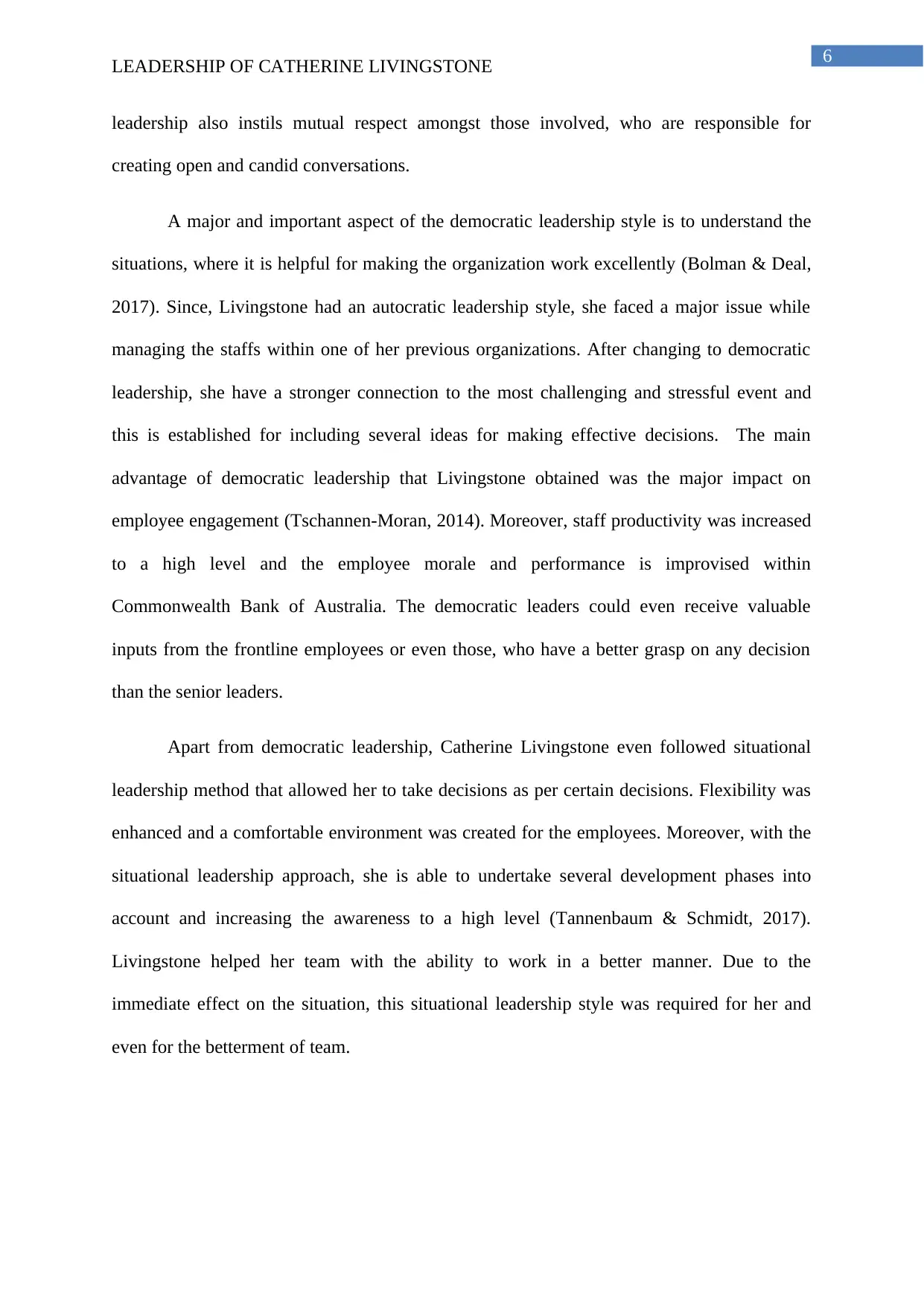
6
LEADERSHIP OF CATHERINE LIVINGSTONE
leadership also instils mutual respect amongst those involved, who are responsible for
creating open and candid conversations.
A major and important aspect of the democratic leadership style is to understand the
situations, where it is helpful for making the organization work excellently (Bolman & Deal,
2017). Since, Livingstone had an autocratic leadership style, she faced a major issue while
managing the staffs within one of her previous organizations. After changing to democratic
leadership, she have a stronger connection to the most challenging and stressful event and
this is established for including several ideas for making effective decisions. The main
advantage of democratic leadership that Livingstone obtained was the major impact on
employee engagement (Tschannen-Moran, 2014). Moreover, staff productivity was increased
to a high level and the employee morale and performance is improvised within
Commonwealth Bank of Australia. The democratic leaders could even receive valuable
inputs from the frontline employees or even those, who have a better grasp on any decision
than the senior leaders.
Apart from democratic leadership, Catherine Livingstone even followed situational
leadership method that allowed her to take decisions as per certain decisions. Flexibility was
enhanced and a comfortable environment was created for the employees. Moreover, with the
situational leadership approach, she is able to undertake several development phases into
account and increasing the awareness to a high level (Tannenbaum & Schmidt, 2017).
Livingstone helped her team with the ability to work in a better manner. Due to the
immediate effect on the situation, this situational leadership style was required for her and
even for the betterment of team.
LEADERSHIP OF CATHERINE LIVINGSTONE
leadership also instils mutual respect amongst those involved, who are responsible for
creating open and candid conversations.
A major and important aspect of the democratic leadership style is to understand the
situations, where it is helpful for making the organization work excellently (Bolman & Deal,
2017). Since, Livingstone had an autocratic leadership style, she faced a major issue while
managing the staffs within one of her previous organizations. After changing to democratic
leadership, she have a stronger connection to the most challenging and stressful event and
this is established for including several ideas for making effective decisions. The main
advantage of democratic leadership that Livingstone obtained was the major impact on
employee engagement (Tschannen-Moran, 2014). Moreover, staff productivity was increased
to a high level and the employee morale and performance is improvised within
Commonwealth Bank of Australia. The democratic leaders could even receive valuable
inputs from the frontline employees or even those, who have a better grasp on any decision
than the senior leaders.
Apart from democratic leadership, Catherine Livingstone even followed situational
leadership method that allowed her to take decisions as per certain decisions. Flexibility was
enhanced and a comfortable environment was created for the employees. Moreover, with the
situational leadership approach, she is able to undertake several development phases into
account and increasing the awareness to a high level (Tannenbaum & Schmidt, 2017).
Livingstone helped her team with the ability to work in a better manner. Due to the
immediate effect on the situation, this situational leadership style was required for her and
even for the betterment of team.
Paraphrase This Document
Need a fresh take? Get an instant paraphrase of this document with our AI Paraphraser
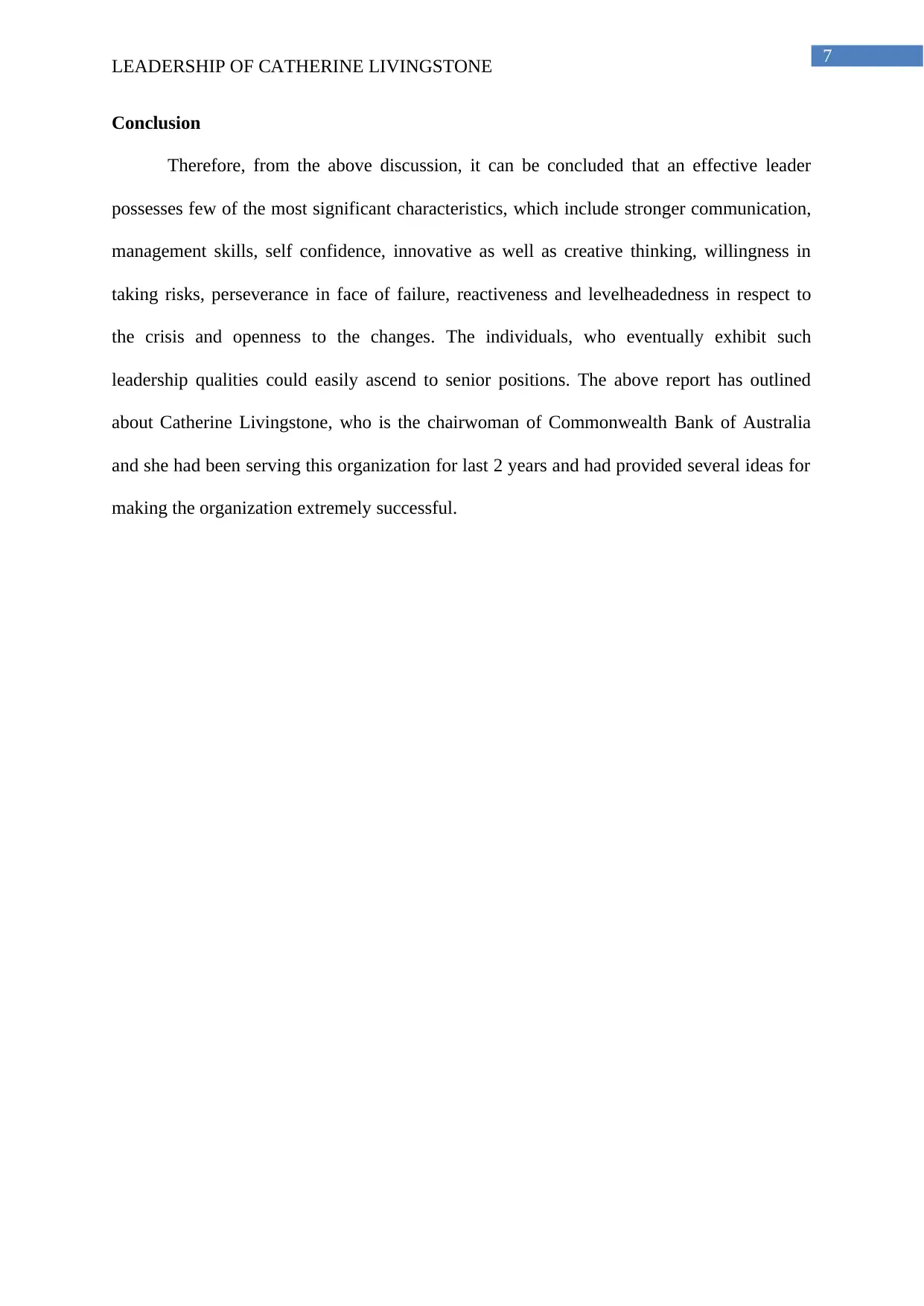
7
LEADERSHIP OF CATHERINE LIVINGSTONE
Conclusion
Therefore, from the above discussion, it can be concluded that an effective leader
possesses few of the most significant characteristics, which include stronger communication,
management skills, self confidence, innovative as well as creative thinking, willingness in
taking risks, perseverance in face of failure, reactiveness and levelheadedness in respect to
the crisis and openness to the changes. The individuals, who eventually exhibit such
leadership qualities could easily ascend to senior positions. The above report has outlined
about Catherine Livingstone, who is the chairwoman of Commonwealth Bank of Australia
and she had been serving this organization for last 2 years and had provided several ideas for
making the organization extremely successful.
LEADERSHIP OF CATHERINE LIVINGSTONE
Conclusion
Therefore, from the above discussion, it can be concluded that an effective leader
possesses few of the most significant characteristics, which include stronger communication,
management skills, self confidence, innovative as well as creative thinking, willingness in
taking risks, perseverance in face of failure, reactiveness and levelheadedness in respect to
the crisis and openness to the changes. The individuals, who eventually exhibit such
leadership qualities could easily ascend to senior positions. The above report has outlined
about Catherine Livingstone, who is the chairwoman of Commonwealth Bank of Australia
and she had been serving this organization for last 2 years and had provided several ideas for
making the organization extremely successful.
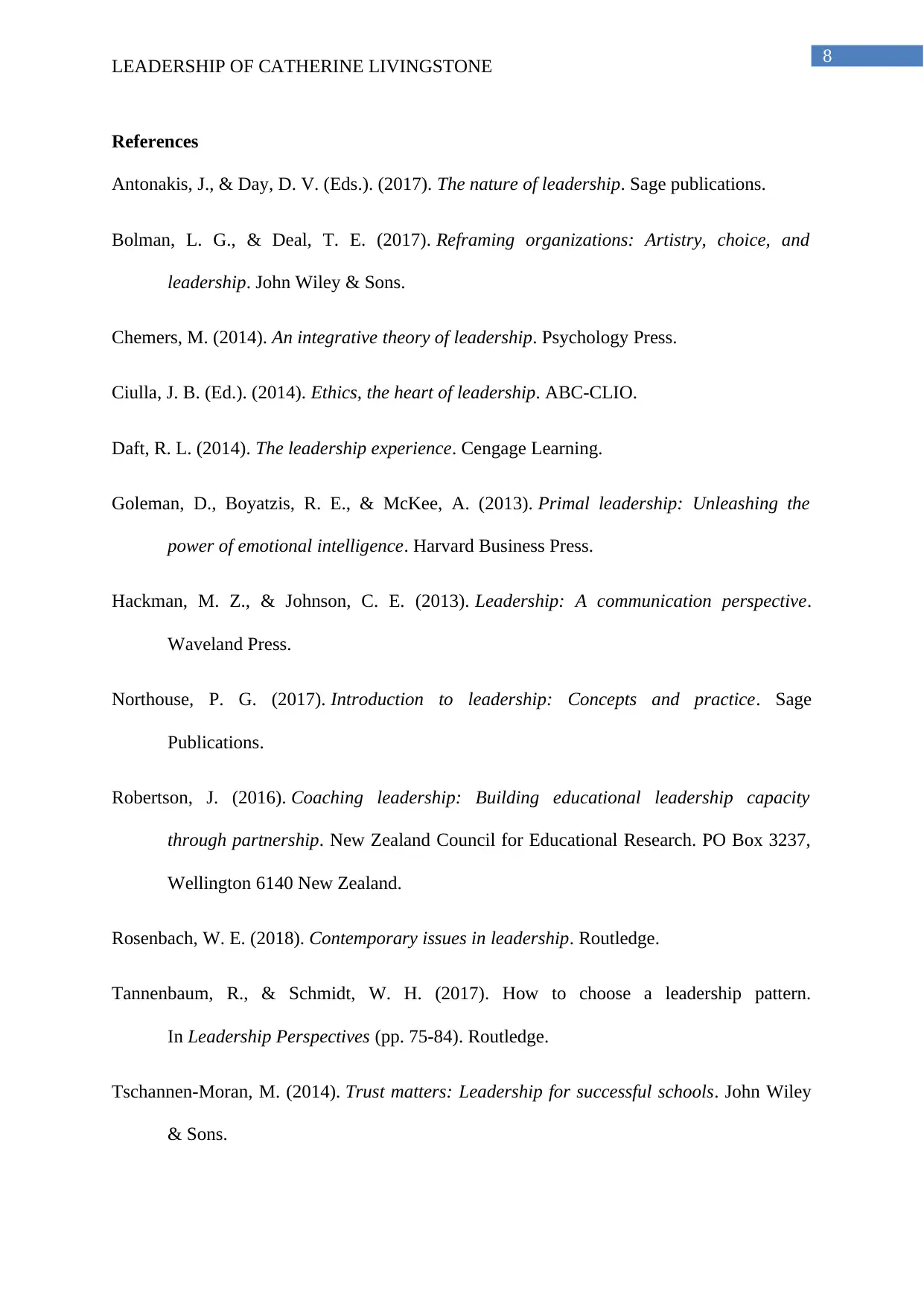
8
LEADERSHIP OF CATHERINE LIVINGSTONE
References
Antonakis, J., & Day, D. V. (Eds.). (2017). The nature of leadership. Sage publications.
Bolman, L. G., & Deal, T. E. (2017). Reframing organizations: Artistry, choice, and
leadership. John Wiley & Sons.
Chemers, M. (2014). An integrative theory of leadership. Psychology Press.
Ciulla, J. B. (Ed.). (2014). Ethics, the heart of leadership. ABC-CLIO.
Daft, R. L. (2014). The leadership experience. Cengage Learning.
Goleman, D., Boyatzis, R. E., & McKee, A. (2013). Primal leadership: Unleashing the
power of emotional intelligence. Harvard Business Press.
Hackman, M. Z., & Johnson, C. E. (2013). Leadership: A communication perspective.
Waveland Press.
Northouse, P. G. (2017). Introduction to leadership: Concepts and practice. Sage
Publications.
Robertson, J. (2016). Coaching leadership: Building educational leadership capacity
through partnership. New Zealand Council for Educational Research. PO Box 3237,
Wellington 6140 New Zealand.
Rosenbach, W. E. (2018). Contemporary issues in leadership. Routledge.
Tannenbaum, R., & Schmidt, W. H. (2017). How to choose a leadership pattern.
In Leadership Perspectives (pp. 75-84). Routledge.
Tschannen-Moran, M. (2014). Trust matters: Leadership for successful schools. John Wiley
& Sons.
LEADERSHIP OF CATHERINE LIVINGSTONE
References
Antonakis, J., & Day, D. V. (Eds.). (2017). The nature of leadership. Sage publications.
Bolman, L. G., & Deal, T. E. (2017). Reframing organizations: Artistry, choice, and
leadership. John Wiley & Sons.
Chemers, M. (2014). An integrative theory of leadership. Psychology Press.
Ciulla, J. B. (Ed.). (2014). Ethics, the heart of leadership. ABC-CLIO.
Daft, R. L. (2014). The leadership experience. Cengage Learning.
Goleman, D., Boyatzis, R. E., & McKee, A. (2013). Primal leadership: Unleashing the
power of emotional intelligence. Harvard Business Press.
Hackman, M. Z., & Johnson, C. E. (2013). Leadership: A communication perspective.
Waveland Press.
Northouse, P. G. (2017). Introduction to leadership: Concepts and practice. Sage
Publications.
Robertson, J. (2016). Coaching leadership: Building educational leadership capacity
through partnership. New Zealand Council for Educational Research. PO Box 3237,
Wellington 6140 New Zealand.
Rosenbach, W. E. (2018). Contemporary issues in leadership. Routledge.
Tannenbaum, R., & Schmidt, W. H. (2017). How to choose a leadership pattern.
In Leadership Perspectives (pp. 75-84). Routledge.
Tschannen-Moran, M. (2014). Trust matters: Leadership for successful schools. John Wiley
& Sons.
⊘ This is a preview!⊘
Do you want full access?
Subscribe today to unlock all pages.

Trusted by 1+ million students worldwide
1 out of 9
Related Documents
Your All-in-One AI-Powered Toolkit for Academic Success.
+13062052269
info@desklib.com
Available 24*7 on WhatsApp / Email
![[object Object]](/_next/static/media/star-bottom.7253800d.svg)
Unlock your academic potential
Copyright © 2020–2025 A2Z Services. All Rights Reserved. Developed and managed by ZUCOL.





